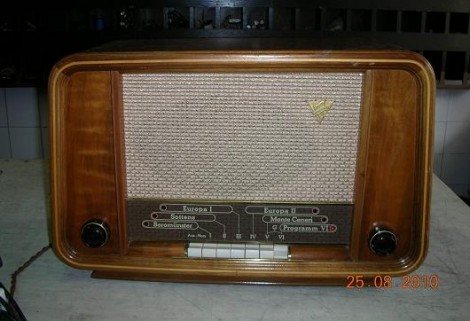
This vintage radio can play AM, FM, and MP3, all with a classic sound. Inside you’ll find a new AM radio tube-amp, providing the functionality you’d expect from the device. The rest of it comes from a conglomeration of parts; an FM receiver board from another radio and an MP3 player with remote control and USB connector. The classic sound we mentioned above comes from an AM modulator. That’s right, the auxiliary audio boards aren’t connected directly, but are broadcast on the AM band so that your latest MC Lars album has the same sound quality as the traffic report.
Check out this similar project from last year that adds RDS to a vintage radio.















Take it one step further and make it internet enabled – it checks the weather forecasts every so often, and modifies the signal strength of the AM modulator depending on the time of day and weather conditions.
I did a similar project as diploma work. Unfortunately its only available in german. I removed all internal parts and used an openWrt router, LCD display, usb keypad etc. check
http://www.neophob.com/2008/07/diplomarbeit-embedded-linux-german/
Wish there was a more in-depth write-up for this. And higher res pics.
Also, respect for adding functionality to a vintage radio with next to no alterations to the original components. It’s how it should be done.
iirc its basically a variable frequency oscillator with an AM modulation circuit..
in fact a 455 MHz resonator from a broken remote control ought to work, and the circuit is a single JFET… the slight variation in frequency is a non issue.
@Tachikoma: says in his write up the tube radio is actually new and home-brewed. It was originally a Switzerland-only cable radio receiver but the service is now defunct. I never heard of a nationwide system like that before, especially that early.
anyone could gut it and stuff it with modern parts, but to make a modern board, and interface it to the amp and switch panel is just awesome!!
Very cool, I love old electronics and this puts them togther with the new in just the right way.
I’d love to hear what it sounds like. also i wonder if it bleeds signal in the am band when there’s an MP3 playing.
@nes : oops can’t believe i missed that. Cool project none the less.
@zeropointmodule
“in fact a 455 MHz resonator”
I think that’s KHz.
Either way it’s a very nice build. I’m not quite sure why he bothered with MP3 support though.
@David: The sound is much better than traditional AM, because this is a direct receiver (not superheterodyne) and the spacing between channels is 33 KHz and his range wider audio bandwidth. Subjective is about 8 kHz. It’s not like FM radio, but is cool.
@Urza: Yes, I thought to add something like IP radio, but I do not have the time and I hate …
@nes: You are not right, it is an authentic Biennophone, I got it in pretty good shape.
@Tachikoma: Yes, the integrity of the old radio is not harm.
Elegant. Looks original. Should sound better than a designer clock case. Those Swiss! cable FM in the fifties, 1000 line analogue TV in seventy’s. It has seen-heard fine programs. AM reception of anything mpee’ed filters out the worst of the annoying shizz that pervades all current sound venues, radio, etc. Unfortunately our AM-FM radio is under attack, with shards of sound. Atwater Kent’s to whats still in your dashboard are ready to become as useless as that Swiss cable radio till it was hacked. I miss 30 years of cable FM, 60’s to 90’s.
@bello: Oops! I understand now. With 33kHz channel spacing I guess the quality of these Biennophones must be pretty good? Comparable to VHF FM wireless even?
How did they stop the telephone wires radiating the signal though? Are they screened in Switzerland?
lol, my girlfriend and I bought ourselves 2 brAuns of 1958. We’re going to restore them and I’m going to implant a squeezebox client in it. The FM range isn’t matching todays range, so with squeezebox-server we could play internet radio..
@nes: wires isn’t screened but balanced and at 300KHz radiating is negligible…
@wouter: Cool.
This is awesome. As above, any chance of an instructable for this? Saving this old technology and giving it new life is so the way to go!